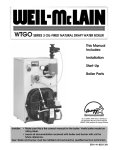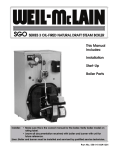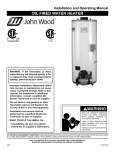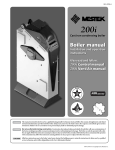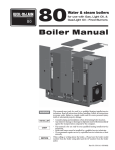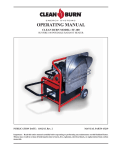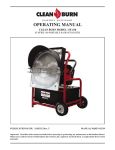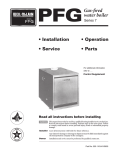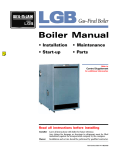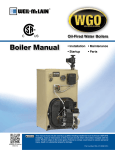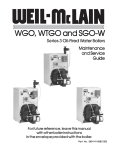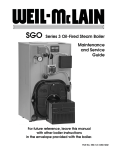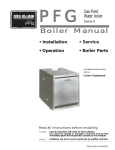Download Weil-McLain 550-141-827/1201 Boiler User Manual
Transcript
SGO-W SERIES 3 OIL-FIRED NATURAL DRAFT WATER BOILER This Manual Includes: Installation Start-Up Boiler Parts Installer: • Make sure this is the correct manual for the boiler. Verify boiler model on rating label. • Leave all documentation received with boiler and burner with unit for future reference. User: Boiler and burner must be installed and serviced by qualified service technician. Part No. 550-141-827/1201 Read This Page First Hazard Definitions The following terms are used to bring attention to the presence of hazards of various risk levels or to important information concerning product life. Indicates presence of hazards that will cause severe personal injury, death or substantial property damage if ignored. Indicates presence of hazards that can cause severe personal injury, death or substantial property damage if ignored. Indicates presence of hazards that will or can cause minor personal injury or property damage if ignored. Indicates special instructions on installation, operation or maintenance that are important but not related to personal injury hazards. Symbol Definitions The following symbols are used to indicate sequence of installation for: Factory-assembled block, no burner. Sizes 3 through 6 with jacket installed; water trim controls shipped separately. Sizes 7 through 9 with jacket and water trim controls shipped separately. When Calling or Writing About the Boiler Please have boiler model number and series from boiler rating label and CP number(s) from boiler jacket, burner and controls. On page 22 of this manual is space to list CP number(s). 2 Table of Contents Read all instructions before installing. Failure to follow all instructions in proper order can cause severe personal injury, death or substantial property damage. Read This Page First . . . . . . . . . . . . . . . . . . . . . . . . . . Table of Contents . . . . . . . . . . . . . . . . . . . . . . . . . . . . Before Installing Boiler . . . . . . . . . . . . . . . . . . . . . . . Install Non-Packaged Boiler . . . . . . . . . . . . . . . . . . . . Connect Breeching . . . . . . . . . . . . . . . . . . . . . . . . . . . Connect Water Piping . . . . . . . . . . . . . . . . . . . . . . . . Connect Tankless Heater Piping . . . . . . . . . . . . . . . . Connect Wiring . . . . . . . . . . . . . . . . . . . . . . . . . . . . . Connect Oil Piping . . . . . . . . . . . . . . . . . . . . . . . . . . . Start-Up . . . . . . . . . . . . . . . . . . . . . . . . . . . . . . . . . . . Check-Out Procedure . . . . . . . . . . . . . . . . . . . . . . . . Installation and Service Certificate . . . . . . . . . . . . . . Appendix . . . . . . . . . . . . . . . . . . . . . . . . . . . . . . . . . . Parts List . . . . . . . . . . . . . . . . . . . . . . . . . . . . . . . . . . Parts Drawing . . . . . . . . . . . . . . . . . . . . . . . . . . . . . . . Dimensions . . . . . . . . . . . . . . . . . . . . . . . . . . . . . . . . . Ratings . . . . . . . . . . . . . . . . . . . . . . . . . . . . . . . . . . . . . . . . . . . . . . . . . . . . . . . . . . . . . . . . . . . . . . . . . . . . . . . . . . . . . . . .2 .3 .4-5 .6-9 .10-11 .12-16 .16-17 .18-19 .20 .21 .22 .22 .23 .24 .25 .26-27 .Back Cover 3 Before Installing Boiler Installations must comply with: • U.S. — State and local plumbing, heating and electrical codes. — National codes where applicable. Canada — Canadian Standards Association, CSA B139, Installation Code for Oil-Burning Equipment. — CSA C22.1 Canadian Electrical Code Part One. — Applicable local or provincial codes. • Provide clearances around boiler (see FIGURE 1): Jacket cap must be in place on boiler to avoid requiring an 18" minimum clearance from back or top of boiler to combustible material. • Before selecting boiler location: • Check for nearby connections to: — System water piping. — Chimney. See pages 10-11. Boiler can be top or back vented. — Combustion and ventilation air supply. See page 5. — Oil supply. See page 20 for oil line routing. — Electrical power. Check area around boiler. Remove any combustible materials, gasoline and other flammable liquids. • Minimum clearances from vent pipe to combustible material: 6 inches — Type “L” doublewall vent* 18 inches — Singlewall vent* Flue pipe clearances must take precedence over jacket clearances. • Recommended service clearances: 24 inches — Front and top 6 inches — Left side**, back and right side ∆ 15 inches — Left side with tankless heater** 12 inches — Right side for burner door swing radius ∆ Failure to keep boiler area clear and free of combustible materials, gasoline and other flammable liquids and vapors can result in severe personal injury, death or substantial property damage. Ceiling * 6" (18") * 6" (18") 24" Walls 6" (12") ∆ * 6" (18") 6" 24" 6" (15")* * Wall Floor Top View 4 Left Side Recommended Service Clearances FIGURE 1 Before Installing Boiler Provide air for combustion and ventilation: • Adequate combustion and ventilation air: • Assures proper combustion. • Reduces risk of severe personal injury or death from possible flue gas leakage and carbon monoxide emissions. Do not install exhaust fan in boiler room. • Older buildings with single-pane windows, minimal weather-stripping and no vapor barrier often provide enough natural infiltration and ventilation without dedicated openings. New construction or remodeled buildings are most often built tighter. Windows and doors are weather-stripped, vapor barriers are used and openings in walls are caulked. As a result, such tight construction is unlikely to allow proper natural air infiltration and ventilation. Follow state, provincial or local codes when sizing adequate combustion and ventilation air openings. In absence of codes, use the following guidelines when boiler is in a confined room (defined by NFPA 31 as less than 7200 cubic feet per 1 GPH input of all appliances in area. A room 8 ft. high x 33.5 ft. x 33.5 ft. is 7200 cu. ft.): Provide two permanent openings — one within 12 inches of ceiling, one within 12 inches of floor. Minimum height or length dimension of each rectangular opening should be at least 3 inches. When inside air is used — each opening must freely connect with areas having adequate infiltration from outside. Each opening should be at least 140 sq. in. per 1 GPH input (1 sq. in. per 1000 Btu input) of all fuel-burning appliances plus requirements for any equipment that can pull air from room (including clothes dryer and fireplace). When outside air is used — connect each opening directly or by ducts to the outdoors or to crawl or attic space that freely connects with outdoors. Size per below: • Through outside wall or vertical ducts — at least 35 sq. in. per 1 GPH input (1 sq. in. per 4000 Btu input) of all fuel-burning appliances plus requirements for any equipment that can pull air from room (including clothes dryer and fireplace). CONTINUED Through horizontal ducts — at least 70 sq. in. per 1 GPH boiler input (1 sq. in. per 2000 Btu input) of all fuel-burning appliances plus requirements for any equipment that can pull air from room (including clothes dryer and fireplace). Where ducts are used, they should have same cross-sectional area as free area of openings to which they connect. Compensate for louver, grille or screen blockage when calculating free air openings. Refer to their manufacturer’s instructions for details. If unknown, use: — Wood louvers, which provide 20-25% free air. — Metal louvers or grilles, which provide 60-75% free air. Lock louvers in open position or interlock with equipment to prove open before boiler operation. Lay a foundation, if needed: Boiler may be installed on non-carpeted combustible flooring. For residential garage installation, install boiler so burner is at least 18 inches above floor to avoid contact with gasoline fumes. A level concrete or masonry foundation is required when: • Floor could possibly become flooded. • Non-level conditions exist. Solid concrete blocks can be used to create a pad. BOILER FOUNDATION SIZE TABLE BOILER MODEL LENGTH INCHES WIDTH INCHES MIN. HEIGHT INCHES SGO-3W 17 22 2 SGO-4W 20 22 2 SGO-5W 23 22 2 SGO-6W 26 22 2 SGO-7W 29 22 2 SGO-8W 32 22 2 SGO-9W 35 22 2 5 Install Non-Packaged Boiler Fiberglass wool and ceramic fiber materials: • POSSIBLE CANCER HAZARD BY INHALATION • CAN CAUSE RESPIRATORY, SKIN AND EYE IRRITATION This product contains fiberglass wool and ceramic fiber materials. Airborne fibers from these materials have been listed by the State of California as a possible cause of cancer through inhalation. Apply special care when handling ceramic fiber (chamber lining, base insulation) materials. Ceramic fibers can be converted to chrystobalites, a substance listed as a probable cause of cancer. Suppliers of fiberglass wool products recommend the following precautions be taken when handling these materials: Precautionary measures: • Avoid breathing fiberglass dust and contact with skin and eyes. • Use NIOSH approved dust/mist respirator. • Wear long-sleeved, loose fitting clothing, gloves and eye protection. • Wash work clothes separately from other clothing. Rinse washer thoroughly. • Operations such as sawing, blowing, tearout and spraying may generate airborne fiber concentration requiring additional protection. First aid measures: • Eye contact — Flush eyes with water to remove dust. If symptoms persist, seek medical attention. • Skin contact — Wash affected areas gently with soap and warm water after handling. Place boiler: 1. A-SGO-3 through 6W — position on site. Smaller-sized boilers may be top heavy. Use caution when handling to avoid minor personal injury or property damage. a. Boiler is shipped for back flue outlet. To change to top flue outlet (see FIGURE 2): 1) Loosen two screws holding flue cap strap to collector hood. Remove strap and flue cap from opening. Re-tighten screws. 2) Check rope placement inside flue cap. (Read page 7.) 6 under Step #3 on 3) Loosen two screws on back flue outlet. Set flue cap on outlet. Install strap by engaging slots in screws. Tighten screws. Make sure cap is securely installed. 2. A-SGO-7, 8 & 9W— split the assembled block for easier handling (see FIGURE 2): a. Open burner mounting door and, using utility knife, slit floor insulation at joint to be separated. b. Remove 5½" draw rod and the longest draw rod from each side. Pull block apart. Save draw rods, nuts, washers and sealing rings for reassembly. c. Move divided block to location. d. Clean port openings with clean rag. Do not use petroleum-based compounds to clean openings. Damage to system components can result, causing property damage. e. Place rings in port openings. If ring slips out of groove, stretch ring gently for several seconds, then place in groove. f. Position sections so aligning lugs fit into sockets of next section. Make sure sealing rope is in good condition and in position. g. Oil threads on draw rods. Install washer and nut on end to be tightened. Use nut only on other end. h. With wrench at washer/nut end, uniformly tighten nuts starting with 5½" rod at large port, 5½" rod at small port, bottom long rod and finally top long rod. i. Torque on both 5½" rods and bottom long rod should be 50-60 ft. lbs; long top rod should be 20-25 ft. lbs. Do not back-off nuts. j. Metal-to-metal contact should be made around port openings. If gap does exist, it should be less than .020". Check with feeler gauge. k. If gap around port openings exceeds .020", check for dirt on port openings, sockets or misaligned lugs. If corrections are made and gap still exists, contact your Weil-McLain distributor or sales office before continuing installation. Install Non-Packaged Boiler 3. A-SGO-7, 8 & 9W — install flue collector hood (see FIGURE 2): Obtain gas-tight seal to prevent possible flue gas leakage and carbon monoxide emissions, leading to severe personal injury or death. a. Thread tinnerman clip on screw so that clip fits snugly in notch of hold-down lug. Screw must not turn. b. Remove paper on sealing rope. Starting at back section near flue collar, position sealing rope around top of block with adhesive side to sections. Do not stretch rope. Make sure rope ends meet. Trim excess rope. c. Position flue collector hood on top of boiler sections and over screws and clips as shown in FIGURE 2. d. Install washers and nuts. Tighten nuts until collector hood makes contact with tinnerman clip. e. Back flue outlet boiler — Position flue cap and strap over opening in flue collector hood. Make sure rope in cap is in place and in good condition. Tighten strap to hood with screws provided. Top flue outlet boiler — Position flue cap and strap over opening in back section. Make sure rope in cap is in place and in good condition. Tighten strap to boiler with screws provided in section. Install remaining screws in holes in flue collector hood. 4. Check level. Shim legs, if needed. Nut Washer Sealing Rope in Groove Inside Cap Flue Collector Hood Tankless heater, if used: 1. SGO-3 through 6W — remove knockout in left side jacket panel. 2. Remove tankless heater cover plate and gasket. 3. Install new gasket and tankless heater over studs around opening. Secure with 3/8" nuts. Perform hydrostatic pressure test: 1. See FIGURE 3 and Control Tapping Table on page 8 to install: a. Boiler drain. b. Water pressure gauge (test only). Be sure gauge can handle test pressure. c. Air vent in upper tapping. d. Plugs in remaining tappings. 2. Fill boiler. Vent all air. Pressure test boiler at 11¼2 times working pressure. For boilers split and reassembled, test between 75 and 85 psig. Do not leave boiler unattended. Cold water fill could expand and damage cast iron, resulting in severe personal injury, death or substantial property damage. 3. Check for maintained gauge pressure for more than 10 minutes. Visually check for leaks if gauge pressure drops. 4. Drain boiler. Repair leaks if found. Do not use petroleum-based compounds to repair leaks. Damage to system components can result, causing property damage. 5. Re-test boiler after repairing leaks. 6. Remove pressure gauge, air vent and plugs from tappings used for controls. 7. Visually check: a. Sealing rope placement. b. Metal-to-metal contact around port openings. c. Flue collector hood seal. d. Burner mounting door seal. Sealing Rope with Adhesive Tape Flue Cap Strap Flue Cap CONTINUED Obtain gas-tight seal to prevent possible flue gas leakage and carbon monoxide emissions, which can lead to severe personal injury or death. Tinnerman Clip Screw Change from Back Flue Outlet to Top Flue Outlet (Optional) FIGURE 2 7 Install Non-Packaged Boiler Install jacket (sizes 7 through 9 only): Before installing jacket, remove burner mounting door. See jacket instructions for details. Install boiler controls: See Control Tapping Table and FIGURES 3 and 4 to install controls. 1. Install tankless heater control if tankless heater is used. If not furnished, use operating control with maximum 10°F differential. 2. Install limit control. If not furnished, use high limit with maximum 220°F setting. 3. Affix CP number label(s) on jacket front panel. CONTROL TAPPING TABLE TAPPING SIZE FUNCTION A1 1½" Supply Piping A2 2½" Air Vent or Expansion Tank Piping A3 2½" Plugged B1 1½" Return Piping B2 2" Plugged E1 ½" Pressure-Temperature Gauge E2 ½" Plugged H ¾" Drain Valve L ¾" High Limit Control P ¾" Plugged R ¾" Relief Valve S1 & S2 ½" Plugged U1 1" Plugged U2 ¾" Plugged ¾" Operating Control for Tankless Heater (located in heater plate) U3 S1 A1 A2 A3 L E1 E2 P U3 S2 R U1 U2 B2 B1 H Front Section 8 CONTINUED Back Section Control Tapping Location FIGURE 3 Install Non-Packaged Boiler CONTINUED Install burner (also refer to instructions packed with burner): Burners designed for use with Weil-McLain 68 boilers must not be used on GOLD Oil boilers. Contact individual burner manufacturers for GOLD Oil applications. For A-SGO-W boiler: 1. Secure universal mounting flange and gasket to burner mounting door. Use three bolts provided. 2. Secure burner on flange with three bolts. 3. Position burner so end of air tube is level to 1½° tilt downward. Open door to verify burner position. End of air tube should be flush to ¼" recessed from inside wall of burner door refractory. Check for secure placement of insulation on target wall, chamber floor and burner mounting door. Securely close door. Circulator Water Pressure Gauge Limit Control Tankless Heater Control Drain Valve Water Boiler Controls FIGURE 4 9 Connect Breeching General chimney requirements: • Insufficient draft can cause flue gas leakage and carbon monoxide emissions, which will lead to severe personal injury or death. • • Use vent material approved by local codes for oil-fired burners. In their absence, refer to: — NFPA 31, Installation of Oil-Burning Equipment. — NFPA 211, Standard for Chimneys, Fireplaces, Vents and Solid Fuel Burning Appliances. — In Canada, refer to CSA B139, Installation Code for Oil-Burning Equipment. NFPA 211 requires chimney to be lined before connected to boiler. Inspect existing chimney before installing new boiler. Failure to do any of the following will result in severe personal injury or death: — Clean chimney, including removal of blockage. — Repair or replace damaged pipe or liner. — Repair mortar and joints. To prevent downdrafts, extend chimney at least 3 feet above highest point where it passes through roof and 2 feet higher than any portion of building within 10 feet. Increase chimney cross-sectional area and height at least 4% per 1,000 feet above sea level. • • MINIMUM CHIMNEY SIZE TABLE Designed for natural draft firing. Connect boiler to vertical chimney. Minimum clearances from vent pipe to combustible material: 6 inches — Type “L” doublewall vent 18 inches — Singlewall vent Minimum chimney sizes should be used. Oversized chimneys, outside masonry chimneys and/or derated inputs can result in condensation in chimney. Connect breeching: Long horizontal breechings, excessive number of tees and elbows or other obstructions restricting combustion gas flow can result in possibility of 10 BOILER MODEL NUMBER *** MINIMUM BREECHING DIAMETER SGO-3W 5" SGO-4W 6" SGO-5W 6" SGO-6W SGO-7W SGO-8W SGO-9W 7" 7" MINIMUM I=B=R CHIMNEY SIZE RECT. 8" x 8" * 8" x 8" * 8" x 12" ** ROUND MINIMUM CHIMNEY HEIGHT 6" 15' 7" 15' 7" 20' * 6¾" x 6¾" inside liner ** 6½" x 10½" inside liner *** Flue collar on boiler is 7" diameter condensation, flue gas leakage and carbon monoxide emissions, which can lead to severe personal injury or death. 1. Install 2 flue pipe brackets. 2. Connect full-sized breeching when possible. See Minimum Chimney Size Table. — Back outlet — see FIGURE 5. — Top outlet — see FIGURE 6. 3. Connection must be made above bottom of chimney to avoid blockage. Breeching must not enter chimney far enough to cause obstruction. Use thimble or slip joint where breeching enters chimney to allow removal for cleaning. 4. When burner and boiler are properly installed, draft overfire will be approximately -0.01" to -0.02" W.C. Install barometric control in breeching, per control manufacturer’s instructions, when excess draft needs to be relieved or to comply with applicable codes and regulations. Use draft gauge to adjust proper opening. 5. An induced draft fan for the chimney may be necessary if: — Excessive resistance to flow of combustion gases can be expected. — Cross-sectional area of chimney is smaller than minimum recommended. — Chimney height is less than recommended. Seal all vent joints. Interlock burner with fan operation. Connect Breeching CONTINUED Typical Location for Barometric Control (Also see Control Manufacturer’s Instructions) Flue Pipe Bracket (One on Each Side of Pipe) Back Outlet Breeching Connection FIGURE 5 Typical Location for Barometric Control (Also see Control Manufacturer’s Instructions) Flue Pipe Bracket (One on Each Side of Pipe) Top Outlet Breeching Connection FIGURE 6 11 Connect Water Piping General piping information: • • • • If installation is to comply with ASME or Canadian requirements, an additional high temperature limit is needed. Install control in supply piping between boiler and isolation valve. Set control to a minimum of 20°F above set point of combination control. Maximum allowable set point is 220°F. Wire control as shown on wiring diagram. Use a low water cutoff device when: — Boiler is installed above radiation level. — Required by certain state or local codes or insurance companies. Use low water cutoff designed for water installations. Probe-type is recommended. Purchase and install in tee in supply line above boiler. Use backflow check valve in cold water supply as required by local codes. “A2” or “A3” tapping not recommended for system supply piping. If “A2” or “A3” tapping must be used, adequate air elimination method must be provided. Install piping: • DIAPHRAGM expansion tank (FIGURE 7): • Undersized expansion tanks cause system water to be lost from relief valve and makeup water added through fill valve. Eventual section failure can result. • • Ensure expansion tank size will handle boiler and system water volume and temperature. Undersized expansion tanks cause system water to be lost from relief valve and makeup water added through fill valve. Eventual section failure can result. • See FIGURE 7 or 8 on page 13 and Water Piping Size Table at right for near-boiler piping and single-zone piping. See page 14 to complete multiple-zone piping or page 15 to complete piping for systems operating below 140°F. Connect tank from “A2” tapping shown in FIGURE 8 to expansion tank. Use 1¼2 " N.P.T. piping. Pitch any horizontal piping up towards tank 1 inch per 5 feet of piping. WATER PIPING SIZE TABLE* Install relief valve vertically in “R” tapping on back of boiler. See FIGURE 7 or 8 and also refer to tag attached to relief valve for manufacturer’s instructions. Pipe relief valve discharge line near floor close to floor drain to eliminate potential of severe burns. Do not pipe to any area where freezing could occur. Do not plug, valve or place any obstruction in discharge line. * 12 Install automatic air vent in “A2” tapping as shown in FIGURE 7. CLOSED expansion tank (FIGURE 8): For multiple-boiler piping, refer to Weil-McLain’s “Primary/Secondary Piping Guide." • Make sure expansion tank size will handle boiler and system water volume and temperature. Tank must be located near boiler before inlet to circulator. See tank manufacturer’s instructions for details. BOILER MODEL NUMBER TO SYSTEM FROM SYSTEM SGO-3W 1¼" 1¼" SGO-4W 1¼" 1¼" SGO-5W 1½" 1½" SGO-6W 1½" 11¼2 " SGO-7W 1½" 1½" SGO-8W 2" 2" SGO-9W 2" 2" All piping sizes based on 20°F temperature rise through boiler. Connect Water Piping Isolation Valve Cold Water Fill Relief Valve CONTINUED Automatic Air Vent Alternate Location To Diaphragm Expansion Tank and Fittings Isolation Valve Pump From System Isolation Valve To Diaphragm Expansion Tank and Fittings Piping with DIAPHRAGM Expansion Tank FIGURE 7 Cold Water Fill Relief Valve Closed Type Expansion Tank To System Isolation Valve Pump From System Isolation Valve Piping with CLOSED Expansion Tank FIGURE 8 13 Connect Water Piping CONTINUED Piping MULTIPLE ZONES: 1. Follow instructions on page 12 and 13 to install piping near boiler. 2. See FIGURE 9 or 10 to complete installation 3. Zoning with circulators: a. Size each circulator to individual circuit requirements. b. Remove circulator (when furnished as standard equipment). c. Install balancing valves to adjust flow to distribute heat to all zones. d. Separate relay is required for each circulator. 4. Zoning with zone valves: a. Install balancing valves to adjust flow to distribute heat to all zones. b. Separate transformer is required to power zone valves. Refer to “Weil-McLain Zone Valve Wiring Guide” for details. Legend: 1 Isolation valve 2 Flow control valve 3 Circulator 4 Zone valve 5 Drain valve ZONE 2 ZONE 2 ZONE 1 ZONE 1 1 2 1 2 1 3 1 1 1 4 5 5 1 5 14 1 5 Multiple Zoning With CIRCULATORS FIGURE 9 Multiple Zoning With ZONE VALVES FIGURE 10 Connect Water Piping CONTINUED Recommended piping for systems requiring temperatures below 140°F: In most systems, this type of piping is not required. If system water temperature requirements are less than 140°F, such as radiant panels or converted gravity systems, use piping as shown in FIGURE 11 or 12. If system piping is plastic without an oxygen barrier, a heat exchanger must be used. Legend: 1 Isolation valve 2 Flow control valve 3 Circulator 4 System temperature gauge 5 Zone valve 6 Drain valve 7 System temperature valves Adjust these valves so that: - the temperature at gauge 8 is at least 140°F - the temperature at gauge 9 is at least 160°F 8 Blend temperature gauge 9 Boiler temperature gauge Piping with CIRCULATORS FIGURE 11 Piping with ZONE VALVES FIGURE 12 15 Connect Water Piping CONTINUED Use with refrigeration systems: • • Install boiler so that chilled medium is piped in parallel with heating boiler. Use appropriate valves to prevent chilled medium from entering boiler. Consult I=B=R Installation and Piping Guides. If boiler is connected to heating coils located in air handling units where they can be exposed to refrigerated air, use flow control valves or other automatic means to prevent gravity circulation during cooling cycle. Supply Exp. Tank 1 1 Circ. Chiller Circ. Strainer Exp. Tank 1 2 1 1 Isolation Valve 2 Balancing Valve Use with Refrigeration System FIGURE 13 Connect Tankless Heater Piping Hot Water Can Scald! • • • Consumer Product Safety Commission and some states recommend domestic hot water temperature of 130°F or less. When installing an automatic mixing valve, selection and installation must comply with valve manufacturer’s recommendations and instructions. Water heated to a temperature suitable for clothes washing, dish washing and other sanitizing needs will scald and cause injury. 16 • Children, elderly, infirm or physically handicapped persons are more likely to be injured by hot water. Never leave them unattended in or near a bathtub, shower or sink. Never allow small children to use a hot water faucet or draw their own bath. If anyone using hot water in the building fits this description, or if state laws or local codes require certain water temperatures at hot water faucets, take special precautions: — Install automatic mixing valve set according to those standards. — Use lowest practical temperature setting. — Check water temperature immediately after first heating cycle and after any adjustment. Connect Tankless Heater Piping Studies have indicated that dangerous bacteria can form in potable water distribution system if certain minimum water temperatures are not maintained. Contact local health department for more information. TANKLESS HEATER RATINGS TABLE To pipe tankless heater: 1. Size piping no smaller than tankless heater inlet and outlet. 2. Following controls (furnished by others) must be installed: a. Automatic mixing valve. See FIGURE 14. (Read at bottom of p. 16) b. Flow regulating valve. Size according to intermittent draw of tankless heater. See Table at right. Follow valve manufacturer’s instructions to install. 3. Additional anti-scald devices may be installed at each hot water faucet, bath and shower outlet. 4. In hard water areas, soften cold domestic supply water to heaters to prevent lime build-up. These single wall heat exchangers comply with National Standard Plumbing Code provided that: • Boiler water (including additives) is practically nontoxic, having a toxicity rating or class of 1, as listed in Clinical Toxicology of Commercial Products. • Boiler water pressure is limited to max. 30 psig by approved water relief valve. CONTINUED * BOILER MODEL NUMBER HEATER NUMBER INTERMITTENT DRAW RATINGS (GPM)* INLET AND OUTLET TAPPING SIZES SGO-3W 35-S-29 3.50 ¾" SGO-4W 35-S-29 3.75 ¾" SGO-5W 35-S-29 4.00 ¾" SGO-6W 35-S-29 4.00 ¾" SGO-7W 35-S-29 4.00 ¾" SGO-8W 35-S-29 4.00 ¾" SGO-9W 35-S-29 4.00 ¾" Gallons of water per minute heated from 40°F to 140°F with 200°F boiler water temperature. Tested in accordance with I=W=H Testing and Rating Standard for Indirect Tankless Water Heaters Tested with Boilers. Tankless Heater Control Flow Regulating Valve Cold Water Supply Mixed 12" Min. Hot Cold Automatic Mixing Valve Tankless Heater Piping FIGURE 14 17 Connect Wiring General wiring requirements: Junction box (furnished): • Electric shock hazard. Can cause severe personal injury or death if power source, including service switch on boiler, is not disconnected before installing or servicing. • • • Installations must follow these codes: — National Electrical Code, ANSI/NFPA 70, latest edition and any additional national, state or local codes. — In Canada, CSA C22.1 Canadian Electrical Code Part 1 and any local codes. Wiring must be N.E.C. Class 1. If original wire as supplied with boiler must be replaced, type 105°C wire or equivalent must be used. Supply wiring to boiler and additional control wiring must be 14 ga. or heavier. Provide electrical ground at boiler as required by codes. Thermostat wiring: • • • • • • • Burner wiring: • • Install thermostat on inside wall away from influences of drafts, hot or cold water pipes, lighting fixtures, television, sun rays or fireplaces. Follow instructions with thermostat. If it has a heat anticipator, set heat anticipator in thermostat to match power requirements of equipment connected to it. Boiler wiring diagrams give setting for standard equipment. Junction box houses electrical connections for all boiler components. “A” boilers are furnished with burner and limit harnesses. All field-provided high voltage wiring must be sheathed in flexible metal conduit. Connect incoming line voltage “HOT” wire to service switch and neutral wire to white wire. Field-install equipment ground wire to green wire with wire nut. Service switch (15 amp) is provided with boiler. “A” boilers — install switch as shown. Some local codes may require an emergency shut-off switch installed at a location away from boiler. Follow local codes. Burner harness incorporates a disconnect plug, providing a convenient way to disconnect wiring when burner mounting door is opened. On “A” boilers, mount the plug (provided in water trim carton) on the burner housing as shown in FIGURE 15. For Carlin burners, screw burner plug into threaded conduit coupling, then mount this assembly to the burner housing using the chase nipple. Route wires through housing and make connections in burner junction box as shown in boiler wiring diagram. Circulator Wiring Harness (Not Furnished on A Boilers) Tankless Heater Control Wiring Harness (Furnished as part of tankless heater kit as additional equipment from W-M) Limit Wiring Harness Burner Wiring Harness Burner Disconnect Plug 18 Boiler Wiring for Forced Hot Water FIGURE 15 Connect Wiring CONTINUED 19 Connect Oil Piping General oil piping requirements: • • • • Location and installation of oil tanks, oil piping and burners must follow: — NFPA 31, Standard for the Installation of Oil-Burning Equipment. — In Canada, CSA B139, Installation of Oil-Burning Equipment. — Local codes and regulations. — Information provided with burner and fuel pump. If any part of fuel oil tank is above level of burner, an anti-siphon device must be used to prevent flow of oil in case of oil line break. Support oil lines as required by codes. Make tank connections with swing joints or copper tubing to prevent breaking in case the tank settles. Make swing joints so they will tighten as tank settles. Non-hardening pipe joint compounds should be used on all threads. 20 Do not use Teflon tape as an oil pipe sealant. It can cause valves to fail, creating hazards. Do not use compression fittings. • Underground pipe must be run in a casing to prevent oil leaking into ground or under floor. Check local codes for information. Oil piping connection at burner: See FIGURE 16 for recommended connection at burner, allowing burner mounting door to swing open completely for servicing. Recommended Oil Piping Connection to Burner FIGURE 16 Start-Up Follow information below to prevent severe personal injury, death or substantial property damage: • Do not use gasoline crankcase drainings or any oil containing gasoline. See burner manual for proper fuel oil. • Do not attempt to start burner when excess oil has accumulated, when unit is full of vapor or when combustion chamber is very hot. • Do not start burner unless collector hood, flue cap, jacket cap, breeching and burner mounting door are secured in place. • Never burn garbage or paper in the boiler. • Never leave combustible material around it. Fill the system: 1. Close manual and automatic air vents and boiler drain cock. 2. Fill to correct system pressure. Correct pressure will vary with each installation. Normal cold water fill pressure for residential systems is 12 psig. Boiler water pH 7.0 to 8.5 is recommended. Failure to maintain recommended pH level can cause section failure and leaks. 3. Open automatic air vent one turn. 4. Open other vents. a. Starting on the lowest floor, open air vents one at a time until water squirts out. Close vent. b. Repeat with remaining vents. 5. Refill to correct pressure. Tips for water systems: • Check boiler and system piping for leaks. Continual makeup water will reduce boiler life. Minerals can build up in sections, reducing heat transfer and causing cast iron to overheat, resulting in section failure. Failure to maintain recommended pH and repair leaks can cause section iron corrosion, leading to section failure and leaks. Do not use petroleum-based sealing or stop-leak compounds in boiler systems. Damage to system components can result. • • When using antifreeze: Do not use automotive, ethylene glycol, undiluted or petroleumbased antifreeze. Severe personal injury, death or substantial property damage can result. — Use antifreeze especially made for hydronic systems. Inhibited propylene glycol is recommended. — 50% solution provides protection to about -30°F. Do not exceed 50% mixture. — Local codes may require back-flow preventer or actual disconnect from city water supply. — Determine quantity according to system water content. Boiler water content is listed on back cover of manual. Percent of solution will affect sizing of heat distribution units, circulator and expansion tank. — Follow antifreeze manufacturer’s instructions. To place in operation: 1. Verify boiler is filled with water. 2. Open burner mounting door and verify rear target wall, floor and burner door insulations are in proper position. 3. Verify burner mounting door is closed tightly and burner wiring harness is connected to junction box. 4. Factory burner adjustment and settings may not be suitable for specific job conditions. For “A” boilers, see Appendix, page 23. Make final burner adjustments using combustion test equipment to assure proper operation. Do not fire boiler without water. Sections will overheat, damaging boiler and resulting in substantial property damage. 5. Vent air from system. Repeat steps 4 and 5 under “Fill the system.” Air in system can interfere with water circulation and cause improper heat distribution. 6. Check boiler and system piping for leaks. See “Tips for water systems.” 7. Inspect breeching and venting for proper operation. For pH conditions outside 7.0 to 8.5 range or unusually hard water areas (above 7 grains hardness), consult local water treatment company. For additional information, refer to instructions packed with boiler or burner: • Burner Manual • Maintenance and Service Guide for GOLD Oil Water Boilers 21 Check-Out Procedure Check off steps as completed: ❏ ❏ ❏ 1. Boiler and heat distribution units filled with water? ❏ 4. Air purged from oil piping? Piping checked for leaks? ❏ 5. Flue cap in place and tightened? Burner door closed, sealed and nut tight? Burner plugged in and service switch on? 2. Automatic air vent, if used, opened one full turn? 3. Air purged from system? Piping checked for leaks (including tankless heater, if used)? Obtain gas-tight seal to prevent possible flue gas leakage and carbon monoxide emissions, leading to severe personal injury or death. ❏ 6. Proper draft and burner flame? Final adjustment made with combustion test equipment? ❏ 7. Test limit control: While burner is operating, move indicator on limit control below actual boiler water temperature. Burner should go off while circulator continues to operate. Raise setting on limit control above water temperature and burner should re-ignite. ❏ 8. Test additional field-installed controls: If boiler has a low water cutoff, additional high limit or other controls, test for operation as outlined by manufacturer. Burner should be operating and should go off when controls are tested. When controls are restored, burner should re-ignite. ❏ 9. Limit control set to system temperature requirements (max. 220°F)? ❏ 10. For multiple zones, flow adjusted to distribute heat in all zones? ❏ 11. Thermostat heat anticipator setting (if available) set properly? Refer to “Connect wiring,” page 18. ❏ 12. Boiler cycled with thermostat? Raise to highest setting and verify boiler goes through normal start-up cycle. Lower to lowest setting and verify boiler goes off. ❏ 13. Observed several operating cycles for proper operation? ❏ 14. Set room thermostat(s) to desired room temperature? ❏ 15. Completed Installation and Service Certificate below? ❏ 16. Reviewed Maintenance and Service Manual with owner or maintenance person and instructed person to keep for future reference? ❏ 17. Returned all instructions provided with boiler to its envelope and placed with boiler for future reference? Installation and Service Certificate Date Installed: ______________________________________________ ❏ Installation instructions have been followed. Boiler Model Number: __________________Series: _________ ❏ Check-out procedure has been performed. CP Number(s):______________________________________________ ❏ Above information is certified to be correct. Measured Btu or GPH Input: _____________________________ ❏ Information received and left with owner/ maintenance person. Installer:__________________________________________________________________________________________________________________________ (Company) (Address) (Phone) 22 _________________________________________________________________ (Installer’s Signature) Appendix Burner adjustments for “A” boilers: Final burner adjustments must be made using combustion test equipment to assure proper operation. Do not fire boiler without water or sections will overheat. 1. Refer to burner manual for start-up. 2. Allow boiler to heat to design condition. 3. Using combustion test equipment, adjust burner for: a. CO2 between 11% and 12% and 0 smoke. b. -0.01" to -0.02" W.C. draft in combustion chamber. To connect SGO-W boilers to Weil-McLain PLUS indirect-fired water heaters: Install and wire per water heater manual provided with water heater. If boiler already has a tankless heater installed: • Remove tankless heater and install cover plate OR • Leave tankless heater installed. Drain coil and remove piping. Do not plug holes in tankless heater front plate. 23 Parts List Repair parts must be purchased through Weil-McLain for the specific boiler as indicated in the list below. Results from using modified or other manufactured parts will not be covered by warranty and may damage boiler or impair operation. Fig. No. A B C D E W-M Sales Part Number R Wide Front Section (7011) Regular Intermediate Section (7015) Intermediate Section w/Draw Rod Lugs (7016) Back Section w/7" Flue, Supply & 2" Return (7017) Section Replacement Kit (For 1 Joint, includes Seals, Rope,Adhesive and Collector Hood Hardware) Front or Back Section Section Replacement Kit (For 2 Joints, includes Seals, Rope and Adhesive) Intermediate Section Section Assembly Complete, For SGO-3W Section Assembly Complete, For SGO-4W Section Assembly Complete, For SGO-5W Section Assembly Complete, For SGO-6W Section Assembly Complete, For SGO-7W Section Assembly Complete, For SGO-8W Section Assembly Complete, For SGO-9W Collector Hood Kit For SGO-3W* Collector Hood Kit For SGO-4W* Collector Hood Kit For SGO-5W* Collector Hood Kit For SGO-6W* Collector Hood Kit For SGO-7W* Collector Hood Kit For SGO-8W* Collector Hood Kit For SGO-9W* Tie Rod 1 /2 x 5 1/2 (SGO-7, 8, 9W) Tie Rod 1 /2 x 103/ 4 (SGO-2 & 7W) Tie Rod 1 /2 x 121/ 4 (SGO-3W) Tie Rod 1 /2 x 133/ 8 (SGO-7 & 8W) Tie Rod 1 /2 x 14 (SGO-8 &9W) Tie Rod 1 /2 x 15 (SGO-9W) Tie Rod 1 /2 x 153/ 8 (SGO-4W) Tie Rod 1 /2 x 161/ 2 (SGO-9W) Tie Rod 1 /2 x 181/ 2 (SGO-5W) Tie Rod 1 /2 x 215/ 8 (SGO-6W) Tie Rod 1 /2 x 243/ 4 (SGO-7W) Tie Rod 1 /2 x 28 (SGO-8W) Tie Rod 1 /2 x 31 (SGO-9W) Heater Cover Plate Carton (Cover Plate, Gasket, Studs & Nuts) Combustion Chamber Kit (Rear & Frt. Ref., Door Refractory Blanket, Rope, Blanket & Water Glass) Burner Mounting Door Assembly (Door, Obs. Port, Rope, Ins. & Pins) Burner Mounting Door (7070) Door Hinge (7054) Door Refractory Door Refractory Blanket Observation Port Shutter Door Seal Rope 5' 3 /8" Glass Rope For Collector Hood (7' For Largest Size Hood) 386-700-851 386-700-665 386-700-666 386-700-667 386-700-668 386-700-669 386-700-670 386-700-671 386-700-340 386-700-341 386-700-342 386-700-343 450-020-182 450-020-184 450-020-186 560-234-464 560-234-491 560-234-493 560-234-494 560-234-470 560-234-495 560-234-532 560-234-496 560-234-475 560-234-536 560-234-540 560-234-544 560-234-546 389-900-103 386-700-355 386-700-358 330-054-302 330-054-300 386-700-359 591-222-115 460-039-867 590-735-105 590-735-109 S Flue Cap Assembly (Cap, Strap, Rope & Screws) 386-700-344 Flue Brush (123D) 591-706-214 F F F F F F F G G G G G G G G G G G G G H J K L M N P Q * Description Includes flue cap assembly, rope and hardware for installation. 24 316-700-245 316-700-065 316-700-070 316-700-265 386-700-852 Parts Drawing S D F E R G B A J L J J M J G K G C P N Q H 25 Dimensions 20 1/4 [514.4] 7 /4 [196.9] 3 DIMENSIONS - in. BOILER MODEL NUMBER B L SGO-3W 13 1/2 16 7 /8 SGO-4W 16 5/8 20 SGO-5W 19 7/8 231/8 SGO-6W 23 26 1/4 SGO-7W 26 1/8 29 3/8 SGO-8W 29 /4 32 /2 SGO-9W 32 3/8 35 5 /8 Water Supply Piping 1 101/4 [260.4] 355/8 [904.88] 43/8 DIA [111.1] Burner Opening 301/16 [763.6] Return 9 1/2 [241.3] 1 27/16 [61.9] 27/16 [61.9] 1 1/8 [28.6] SGO-W Front DIMENSIONS - mm. 7 3/16 [182.6] BOILER MODEL NUMBER B L SGO-3W 342.9 428.7 SGO-4W 422.1 508.0 SGO-5W 504.9 587.2 SGO-6W 584.2 666.7 SGO-7W 663.4 746.2 SGO-8W 742.9 825.5 SGO-9W 822.4 904.7 7 DIA [177.8] Heater Location B 151/2 [393.7] L 14 Approx. SGO-W Side with Burner 26 Dimensions CONTINUED Intermediate 7 DIA [177.8] 61/4 [158.8] 7 DIA R [177.8] 299/16 [750.9] Back 27 Ratings SGO-W GOLD OIL WATER BOILER RATINGS (1) I=B=R BURNER CAPACITY GPH (3) * * -SGO-3W ROUND DRAFT FLUE BOILER LOSS OUTLET WATER THRU ROUND HEIGHT SIZE CONTENT BOILER IN FT IN (7) GAL IN W.C. (8) DOE HEATING CAPACITY (4) MBH (2) NET I=B=R RATINGS (5) DOE SEASONAL EFFICIENCY % AFUE 0.95 115 100 85.3 8x8 6 15 7 14.6 .020 * *-SGO-4W 1.20 145 126 85.0 8x8 6 15 7 16.3 .010 * *-SGO-5W 1.45 175 152 85.0 8x8 7 15 7 18.8 .015 * *-SGO-6W 1.75 212 184 85.0 8x8 7 15 7 21.2 .015 * *-SGO-7W 2.00 242 210 85.0 8x8 8 15 7 23.7 .015 * *-SGO-8W 2.30 266 (6) 231 — 8 x 12 8 20 7 26.2 .025 * *-SGO-9W 2.55 295 (6) 257 — 8 x 12 8 20 7 28.6 .030 BOILER MODEL NUMBER MINIMUM I=B=R CHIMNEY RECT IN ** Available only as an “A” unit. “A” boiler only for use with approved burners as listed with I=B=R. (1) SGO-W boiler designed with convertible vertical and horizontal flue outlet. (2) MBH refers to thousands of Btu per hour. (3) Based on 140,000 Btu/gal. (4) Based on standard test procedures prescribed by the United States Department of Energy at combustion condition of 13.5% CO 2 and -0.02" W.C. draft overfire. (5) Net I=B=R ratings are based on net installed radiation of sufficient quantity for the requirements of the building and nothing need be added for normal piping and pick-up. Water ratings are based on a piping and pick-up allowance of 1.15. An additional allowance should be made for unusual piping and pick-up loads. Consult local Weil-McLain Sales Office. (6) I=B=R gross output. (7) See page 10 for minimum breeching diameter. (8) Listed draft losses are for factory-shipped settings.




























